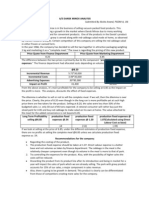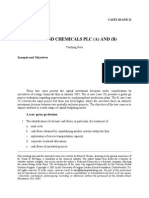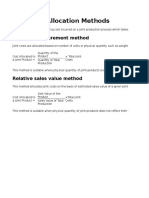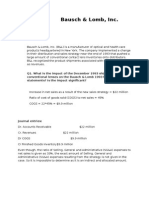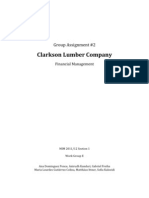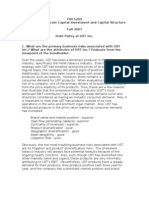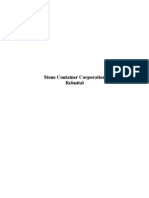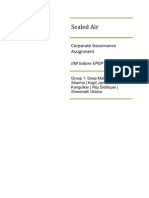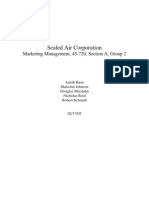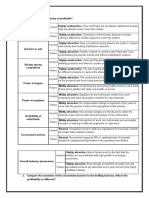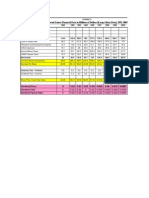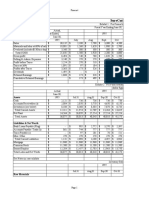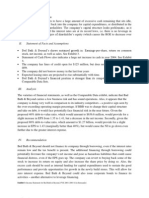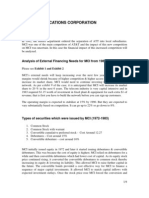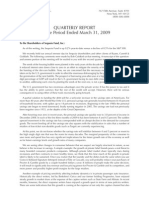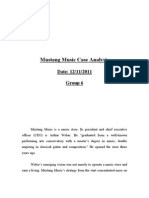Sure Cut
Sure Cut
Uploaded by
chch917Copyright:
Available Formats
Sure Cut
Sure Cut
Uploaded by
chch917Copyright
Available Formats
Share this document
Did you find this document useful?
Is this content inappropriate?
Copyright:
Available Formats
Sure Cut
Sure Cut
Uploaded by
chch917Copyright:
Available Formats
SureCut Shears
1. Describe SureCut Shears in terms of its market, competitive and operating characteristics. How risky is SureCut Shears in operating and competitive terms? SureCut Shears manufactured a line of household scissors and industrial shears. It provides cheaper price to customers and makes profits and grow steadily despite severe competition, which mainly comes from abroad. As to its operation, we can see in the spreadsheets attached, its actual sales changes seasonally. Its current ratio and acid test indicate that a considerable amount of cash is tied up with inventory. The profit margin doesnt look optimistic. The risk lies in the seasonal change in sales, which will lead to excess inventory. 2. What assumptions did Mr. Fischer make when he prepared the forecast shown in case Exhibit 1 and 2? Were these assumptions reasonable? He assumed that the sales wound increase steadily in the last half years in 2005 so he can repay the loans. He also assumed that the cost and expense wound not change dramatically. However, his assumption was not reasonable to a large degree. He failed to estimate the sales recession because the sales change with season and it cannot be predicted so well. And he also didnt assume that the inventory wound tie up so much money. 3. Why was SureCut Shears unable to repay its bank loan by March 31, 1996 as originally forecast? Because, first, the sales didnt go up as expected, leading the revenue down and inventory up. Second, the current ratio (5.34) and the acid test (1.74) showed that its money was to a large extent tied up with inventory. And last, the expenditure was higher than expected. 4. Has SureCuts financial condition worsened sufficiently to cause Mr. Stewart any great concern? Not really. Its problem is not so severe. When the sales go up again with season, it will decrease its inventory to a reasonable level. And then it will benefit from new plant. So the future is good as long as the market recovers. 5. Compare the nature of the financial problems faced by SureCut Shears and Butler Lumber Company. The SureCut Shears faced with cyclic financing problem, while Butler Lumbers problem derived from its rapid growth. The SureCut itself didnt grow so rapidly, it needed extra fund to support its unstable sales and inventory. Butler Lumber needed external fund to support its rapid growth.
You might also like
- Target Corporation: Ackman Versus The Board: FM2 Case Study AnalysisDocument6 pagesTarget Corporation: Ackman Versus The Board: FM2 Case Study AnalysisSuman MandalNo ratings yet
- SureCut Exhibits and QuestionsDocument16 pagesSureCut Exhibits and Questionssergej0% (1)
- Dansk MinoxDocument1 pageDansk MinoxAksha Anand100% (2)
- Cadillac Cody CaseDocument13 pagesCadillac Cody CaseKiran CheriyanNo ratings yet
- Always Use 2 Decimal Places (When % As Percent - Not As Fractions) and Provide Detail of The Calculations MadeDocument2 pagesAlways Use 2 Decimal Places (When % As Percent - Not As Fractions) and Provide Detail of The Calculations MadeKirtiKishanNo ratings yet
- TN20 Diamond Chemicals PLC A and BDocument39 pagesTN20 Diamond Chemicals PLC A and Bsimoon1100% (5)
- Joint Cost SignatronDocument8 pagesJoint Cost SignatronGloryNo ratings yet
- Bausch N LombDocument3 pagesBausch N LombRahul SharanNo ratings yet
- Gulf Oil ExhibitsDocument20 pagesGulf Oil Exhibitsaskpeeves1No ratings yet
- (Holy Balance Sheet) Jones Electrical DistributionDocument29 pages(Holy Balance Sheet) Jones Electrical DistributionVera Lúcia Batista Santos100% (1)
- Stone Container CorporationDocument4 pagesStone Container CorporationHarshit GuptaNo ratings yet
- Assignment #2 Workgroup E IttnerDocument8 pagesAssignment #2 Workgroup E IttnerAziz Abi AadNo ratings yet
- Case Study Debt Policy Ust IncDocument10 pagesCase Study Debt Policy Ust IncWill Tan80% (5)
- Updated Stone Container PaperDocument6 pagesUpdated Stone Container Paperonetime699100% (1)
- Submitted To: Submitted By: Dr. Kulbir Singh Vinay Singh 201922106 Aurva Bhardwaj 201922066 Deepanshu Gupta 201922069 Sameer Kumbhalwar 201922097Document3 pagesSubmitted To: Submitted By: Dr. Kulbir Singh Vinay Singh 201922106 Aurva Bhardwaj 201922066 Deepanshu Gupta 201922069 Sameer Kumbhalwar 201922097Aurva BhardwajNo ratings yet
- Tiffany ReportDocument2 pagesTiffany Reportchch917No ratings yet
- Eskimo PieDocument2 pagesEskimo Piechch91750% (2)
- Surecut Shears, Inc.Document2 pagesSurecut Shears, Inc.RAHUL SHARMANo ratings yet
- Sure CutDocument37 pagesSure Cutshmuup1100% (4)
- Financial Management - Case - Sealed AirDocument7 pagesFinancial Management - Case - Sealed AirAryan AnandNo ratings yet
- Sealed Air CorporationDocument4 pagesSealed Air CorporationValdemar Miguel SilvaNo ratings yet
- SpyderDocument3 pagesSpyderHello100% (1)
- O.M Scoott and Sons Case Study HarvardDocument6 pagesO.M Scoott and Sons Case Study Harvardnicole rodríguezNo ratings yet
- Group2 - Clarkson Lumber Company Case AnalysisDocument3 pagesGroup2 - Clarkson Lumber Company Case AnalysisDavid WebbNo ratings yet
- Spyder Active SportsDocument12 pagesSpyder Active SportsShubham SharmaNo ratings yet
- Clarkson TemplateDocument7 pagesClarkson TemplateJeffery KaoNo ratings yet
- SafeBlend Fracturing ReportDocument3 pagesSafeBlend Fracturing Reportsjois.hsNo ratings yet
- Fuel SalesDocument11 pagesFuel SalesFabiola SE100% (1)
- MCI Communications Draft v11Document6 pagesMCI Communications Draft v11Drake RamorayNo ratings yet
- Corp Gov Group1 - Sealed AirDocument5 pagesCorp Gov Group1 - Sealed Airdmathur1234No ratings yet
- MCI Communications Corporation Final ReportDocument8 pagesMCI Communications Corporation Final Reporttamur_ahanNo ratings yet
- MCI Communications Draft v4Document6 pagesMCI Communications Draft v4Drake Ramoray100% (1)
- Sealed Air CorporationDocument7 pagesSealed Air Corporationhadil_1No ratings yet
- Coursehero 40252829Document2 pagesCoursehero 40252829Janice JingNo ratings yet
- Glaxo ItaliaDocument11 pagesGlaxo ItaliaLizeth RamirezNo ratings yet
- Burton Ch.1 Case Summaries Book ContractsDocument30 pagesBurton Ch.1 Case Summaries Book ContractsMissy MeyerNo ratings yet
- Why Is Soft Drink Industry So Profitable?: Barriers To EntryDocument3 pagesWhy Is Soft Drink Industry So Profitable?: Barriers To EntryVenkatesh BoddepalliNo ratings yet
- Diamond Chemicals Case Study11 - FinalDocument20 pagesDiamond Chemicals Case Study11 - FinalJoao0% (1)
- Sealed Air Corporation's Leveraged RecapitalizationDocument7 pagesSealed Air Corporation's Leveraged RecapitalizationKumarNo ratings yet
- Uttam Kumar Sec-A Dividend Policy Linear TechnologyDocument11 pagesUttam Kumar Sec-A Dividend Policy Linear TechnologyUttam Kumar100% (1)
- Markstrat Report Round 0-3 Rubicon BravoDocument4 pagesMarkstrat Report Round 0-3 Rubicon BravoDebadatta RathaNo ratings yet
- ClarksonDocument22 pagesClarksonfrankstandaert8714No ratings yet
- Massey Ferguson CaseDocument6 pagesMassey Ferguson CaseMeraSultan100% (1)
- Surecut Shears, Inc.: AssetsDocument8 pagesSurecut Shears, Inc.: Assetsshravan76No ratings yet
- Precision Worldwide, Inc.Document3 pagesPrecision Worldwide, Inc.karan_w3No ratings yet
- Shikha Kanwar Diamond Chemicals PLCDocument2 pagesShikha Kanwar Diamond Chemicals PLCShikha KanwarNo ratings yet
- Session 10 Simulation Questions PDFDocument6 pagesSession 10 Simulation Questions PDFVAIBHAV WADHWA0% (1)
- New Microsoft Word DocumentDocument4 pagesNew Microsoft Word DocumentGirish26No ratings yet
- Hampton Machine Tool CompanyDocument2 pagesHampton Machine Tool CompanySam Sheehan100% (1)
- Stone Container CorporationDocument5 pagesStone Container Corporationalice123h21No ratings yet
- Sealed Air CorporationDocument8 pagesSealed Air CorporationJaganathan AbhinavNo ratings yet
- BBB Case Write-UpDocument2 pagesBBB Case Write-UpNeal Karski100% (1)
- Accounting For The IphoneDocument9 pagesAccounting For The IphoneFatihahZainalLim100% (1)
- Case 5Document15 pagesCase 5Qiao LengNo ratings yet
- Sealed Air Corporation v1.0Document8 pagesSealed Air Corporation v1.0KshitishNo ratings yet
- MciDocument4 pagesMciIrene MaNo ratings yet
- Cost Management - Software Associate CaseDocument7 pagesCost Management - Software Associate CaseVaibhav GuptaNo ratings yet
- Surecut Shears, Inc.: Estimating Funds Requirements-Short-Term Sources of FinanceDocument7 pagesSurecut Shears, Inc.: Estimating Funds Requirements-Short-Term Sources of FinancesuwimolJNo ratings yet
- Caso Star Appliance CompanyDocument10 pagesCaso Star Appliance CompanyJuan0% (1)
- ToyworldDocument3 pagesToyworldVinay MohanNo ratings yet
- Mason Hawkins 11q3letterDocument4 pagesMason Hawkins 11q3letterrodrigoescobarn142No ratings yet
- Sequoia Fund, Inc.Document8 pagesSequoia Fund, Inc.twoeight100% (1)
- Ocean CarriersDocument1 pageOcean Carrierschch917No ratings yet
- Continental CarriersDocument2 pagesContinental Carrierschch917100% (1)
- Mustang Music Case AnalysisDocument7 pagesMustang Music Case Analysischch9170% (1)
- Mustang Music Case AnalysisDocument7 pagesMustang Music Case Analysischch9170% (1)


